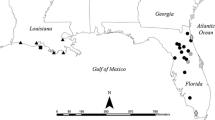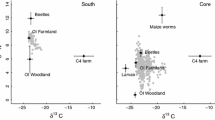Abstract
Intra- and inter-specific resource partitioning within predator communities is a fundamental component of trophic ecology, and one proposed mechanism for how populations partition resources is through individual niche variation. The Niche Variation Hypothesis (NVH) predicts that inter-individual trait variation leads to functional trade-offs in foraging efficiency, resulting in populations composed of individual dietary specialists. The degree to which niche specialization persists within a population is plastic and responsive to fluctuating resource availability. We quantified niche overlap and tested the NVH within an Arctic raptor guild, focusing on three species that employ different foraging strategies: golden eagles (generalists); gyrfalcons (facultative specialists); and rough-legged hawks (specialists). Tundra ecosystems exhibit cyclic populations of arvicoline rodents (lemmings and voles), providing a unique system in which to examine predator diet in response to interannual fluctuations in resource availability. Using blood δ13C and δ15N values from 189 raptor nestlings on Alaska’s Seward Peninsula (2014–2019), we calculated isotopic niche width and used Bayesian stable isotope mixing models (BSIMMs) to characterize individual specialization and test the NVH. Nest-level specialization estimated from stable isotopes was strongly correlated with indices of specialization based on camera trap data. We observed a high degree of isotopic niche overlap between the three species and gyrfalcons displayed a positive relationship between individual specialization and population niche width on an interannual basis consistent with the NVH. Our findings suggest plasticity in niche specialization may reduce intra- and inter-specific resource competition under dynamic ecological conditions.




Similar content being viewed by others
Data archiving statement
Data (except nest locations) and code available from the Dryad digital repository (submission upon acceptance with a one-year embargo); no location data will be provided for raptors as specified by Alaska state law.
References
Adibi SA, Mercer DW (1973) Protein digestion in human intestine as reflected in luminal, mucosal, and plasma amino acid concentrations after meals. J Clin Investig 52(7):1586–1594
Araújo MS, Guimaraes PRJ, Svänback R, Pinheiro A, Guimaraes P, Dos Reis SF, Bolnick DI (2008) Network analysis reveals contrasting effects of intraspecific competition on individual vs population diets. Ecology 89:1981–1993. https://doi.org/10.1890/07-0630.1
Bååth R (2018) bayesboot: an implementation of Rubin's (1981) Bayesian Bootstrap. R package version 0.2.2. https://CRAN.R-project.org/package=bayesboot. Accessed 5 Apr 2022
Bearhop S, Adams CE, Waldron S, Fuller RA, Macleod H (2004) Determining trophic niche width: a novel approach using stable isotope analysis. J Anim Ecol 73:1007–1012. https://doi.org/10.1111/j.0021-8790.2004.00861.x
Bechard MJ, Swem TR, Orta J, Boesman PFD, Garcia EFJ, Marks JS (2020) Rough-legged Hawk (Buteo lagopus), version 1.0. In: Billerman SM (ed) Birds of the World. Cornell Lab of Ornithology, Ithaca. https://doi.org/10.2173/bow.rolhaw.01
Bison M, Ibanez S, Redjadj C, Boyer F, Coissac E, Miquel C, Rioux D, Said S, Maillard D, Taberlet P, Gilles N, Anne Y (2015) Upscaling the niche variation hypothesis from the intra- to the inter-specific level. Oecologia 179:835–842. https://doi.org/10.1007/s00442-015-3390-7
Bolnick DI, Yang LH, Fordyce JA, Davis JM, Svänback R (2002) Measuring individual-level resource specialization. Ecology 83:2936–2941. https://doi.org/10.2307/3072028
Bolnick DI, Svanbäck R, Fordyce JA, Yang LH, Davis JM (2003) The ecology of individuals: incidence and implications of individual specialization. Am Nat 161:1–28. https://doi.org/10.1086/343878
Bolnick DI, Svänback R, Araujo MS, Persson L (2007) Comparative support for the niche variation hypothesis that more generalized populations also are more heterogeneous. Proc Natl Acad Sci 104:10075–10079. https://doi.org/10.1073/pnas.0703743104
Bolnick DI, Amarasekare P, Araújo MS, Bürger R, Levine JM, Novak M, Rudolf VHW, Schreiber SJ, Urban MC, Vasseur DA (2011) Why intraspecific trait variation matters in community ecology. Trends Ecol Evol 26:183–192. https://doi.org/10.1016/j.tree.2011.01.009
Bond A, Diamond AW (2011) Recent Bayesian stable-isotope mixing models are highly sensitive to variation in discrimination factors. Ecol Appl 21:1017–1023. https://doi.org/10.1890/09-2409.1
Booms TL, Cade TJ, Clum NJ (2020) Gyrfalcon (Falco rusticolus), version 1.0. In: Billerman SM (ed) Birds of the World. Cornell Lab of Ornithology, Ithaca. https://doi.org/10.2173/bow.gyrfal.01
Cade TJ (1982) Falcons of the world. Cornell Univ. Press, Ithaca
Cribari-Neto F, Zeileis A (2010) Beta Regression in R. J Stat Softw 34(2):1–24. https://doi.org/10.18637/jss.v034.i02
Eckrich CA, Albeke SE, Flaherty EA, Bowyer RT, Ben-David M (2020) rKIN: kernel-based method for estimating isotopic niche size and overlap. J Anim Ecol 89:757–771. https://doi.org/10.1111/1365-2656.13159
Eisaguirre JM, Booms TL, Schempf PF, Lewis SB (2016) Gyrfalcon home ranges and movements on the Yukon-Kuskokwim Delta, Alaska. J Raptor Res 50:109–114. https://doi.org/10.3356/rapt-50-01-109-114.1
Fufachev IA, Sokolov VA, Ehrich D, Sokolova NA, Sokolov AA (2019) Flexibility in a changing arctic food web: can rough-legged buzzards cope with changing small rodent communities? Glob Change Biol 25:3669–3679. https://doi.org/10.1111/gcb.14790
Gorokhova E (2018) Individual growth as a non-dietary determinant of the isotopic niche metrics. Methods Ecol Evol 9(2):269–277. https://doi.org/10.1111/2041-210X.12887
Herrera G, Rodríguez MMA (2013) Isotopic niche mirrors trophic niche in a vertebrate island invader. Oecologia 171:537–544. https://doi.org/10.1007/s00442-012-2423-8
Herzog JL, Eisaguirre JM, Linkhart BD, Booms TL (2019) Golden eagle diet in Western Alaska. J Raptor Res 53:393–401. https://doi.org/10.3356/0892-1016-53.4.393
Hette-Tronquart N (2019) Isotopic niche is not equal to trophic niche. Ecol Lett 22:1987–1989. https://doi.org/10.1111/ele.13218
Hutchinson GE (1957) Concluding remarks. Cold Spring Harb Symp Quant Biol 22:415–427. https://doi.org/10.1101/SQB.1957.022.01.039
Ims RA, Henden JA, Killengreen ST (2008) Collapsing population cycles. Trends Ecol Evol 23(2):79–86. https://doi.org/10.1016/j.tree.2007.10.010
Jackson AL, Inger R, Parnell AC, Bearhop S (2011) Comparing isotopic niche widths among and within communities: SIBER—Stable Isotope Bayesian Ellipses in R. J Anim Ecol 80:595–602. https://doi.org/10.1111/j.1365-2656.2011.01806.x
Johnson DL, Henderson MT, Booms TL, Williams CT, Anderson DL (2020) Bayesian stable isotope mixing models effectively characterize the diet of an Arctic raptor. J Anim Ecol. https://doi.org/10.1111/1365-2656.13361
Johnson DL (2021) Stable isotope ecology of an Arctic raptor guild. Doctoral dissertation, University of Alaska Fairbanks. ProQuest Dissertations Publishing. 28650116
Katzner TE, Kochert MN, Steenhof K, McIntyre CL, Craig EH, Miller TA (2020) Golden eagle (Aquila chrysaetos), version 2.0. In: Rodewald PG, Keeney BK (eds) Birds of the World. Cornell Lab of Ornithology, Ithaca. https://doi.org/10.2173/bow.goleag.02
Kitowski I (2009) Social learning of hunting skills in juvenile marsh harriers Circus aeruginosus. J Ethol 27(3):327–332. https://doi.org/10.1007/s10164-008-0123-y
L’Herault VL, Franke A, Lecomte N, Alogut A, Bety J (2013) Landscape heterogeneity drives intra-population niche variation and reproduction in an arctic top predator. Ecol Evol 3:2867–2879. https://doi.org/10.1002/ece3.675
MacArthur RH, Pianka ER (1966) On optimal use of a patchy environment. Am Nat 100:603–609
Maldonado K, Bozinovic F, Newsome SD, Sabat P (2017) Testing the niche variation hypothesis in a community of passerine birds. Ecology 98:903–908. https://doi.org/10.1002/ecy.1769
Newsome SD, Yeakel JD, Wheatley PV, Tinker MT (2012) Tools for quantifying isotopic niche space and dietary variation at the individual and population level. J Mammal 93(2):329–341
Peterson RM, Batzli GO (1975) Activity patterns in natural populations of the brown lemming (Lemmus trimucronatus). J Mammal 56:718–720. https://doi.org/10.2307/1379498
Phillips DL, Eldridge PM (2006) Estimating the timing of diet shifts using stable isotopes. Oecologia 147(2):195–203. https://doi.org/10.1007/s00442-005-0292-0
Post DM, Layman CA, Arrington DA (2006) Getting to the fat of the matter: models, methods and assumptions for dealing with lipids in stable isotope analyses. Oecologia 152:179–189. https://doi.org/10.1007/s00442-006-0630-x
Post E, Forchhammer MC, Bret-Harte MS, Callaghan TV, Christensen TR, Elberling B, Fox AD, Gilg O, Hik DS, Høye TT, Ims RA et al (2009) Ecological dynamics across the arctic associated with recent climate change. Science. https://doi.org/10.1126/science.1173113
Pyke GH, Pulliam HR, Charnov EL (1977) Optimal Foraging: a selective review of theory and tests. Q Rev Biol 52:137–154
Reierth E, Stokkan KA (1998) Activity rhythm in high Arctic Svalbard ptarmigan (Lagopus mutus hyperboreus). Can J Zool 76:2031–2039. https://doi.org/10.1139/z98-173
Robinson BW, Prostor M (2017) Guidelines for conducting a camera study of nesting raptors. In: Anderson DL, McClure CJW, Franke A (eds) Applied raptor ecology: essentials from Gyrfalcon research. The Peregrine Fund, Boise, pp 283–298. https://doi.org/10.4080/are.2017/app2
Robinson BG, Franke A, Derocher AE (2018) Stable isotope mixing models fail to estimate the diet of an avian predator. Auk 135:60–70. https://doi.org/10.1642/AUK-17-143.1
Robinson BW, Booms TL, Bechard MJ, Anderson DL (2019) Dietary plasticity in a specialist predator, the gyrfalcon (Falco rusticolus): new insights into diet during brood rearing. J Raptor Res 53:115–126. https://doi.org/10.3356/JRR-15-58
Roughgarden J (1972) Evolution of niche width. Am Nat 106:683–718. https://doi.org/10.1086/282807
Schoener TW (1982) The controversy over interspecific competition. Am Sci 70:586–595
Shipley ON, Matich P (2020) Studying animal niches using bulk stable isotope ratios: an updated synthesis. Oecologia 193:27–51
Smith JA, Mazumder D, Suthers IM, Taylor MD (2013) To fit or not to fit: evaluating stable isotope mixing models using simulated mixing polygons. Methods Ecol Evol 4(7):612–618
Springer AM (1975) Observations on the summer diet of rough-legged Hawks from Alaska. Condor 77:338–339. https://doi.org/10.2307/1366233
Stock BC, Semmens BX (2016) Unifying error structures in commonly used biotracer mixing models. Ecology 97:2562–2569. https://doi.org/10.1002/ecy.1517
Svanbäck R, Bolnick DI (2005) Intraspecific competition affects the strength of individual specialization: an optimal diet theory method. Evol Ecol Res 7(7):993–1012
Swan GJF, Goodwin CED, Bearhop S, Redpath SM, Mcdonald RA, Silk MJ, Inger R (2020) Evaluating Bayesian stable isotope mixing models of wild animal diet and the effects of trophic discrimination factors and informative priors. Methods Ecol Evol 2020:139–149. https://doi.org/10.1111/2041-210X.13311
Therrien J, Gauthier G, Korpimaki E, Bety J (2014) Predation pressure by avian predators suggests summer limitation of small-mammal populations in the Canadian Arctic. Ecology 95:56–67. https://doi.org/10.1890/13-0458.1
Toscano BJ, Gownaris NJ, Heerhartz SM (2016) Personality, foraging behavior and specialization: integrating behavioral and food web ecology at the individual level. Oecologia 182:55–69. https://doi.org/10.1007/s00442-016-3648-8
Van Valen L (1965) Morphological variation and width of ecological niche. Am Nat 99:377–390. https://doi.org/10.1086/282379
Viereck LA, Dyrness CT, Batten AR, Wenzlick KJ (1992) The Alaska vegetation classification. Gen. Tech. Rep. PNW-GTR-286. US Department of Agriculture, Forest Service, Pacific Northwest Research Station, Portland 278, pp 286
Williams CT, Barnes BM, Yan L, Buck CL (2017) Entraining to the polar day: circadian rhythms in arctic ground squirrels. J Exp Biol 220:3095–3102. https://doi.org/10.1242/jeb.159889
Zaccarelli N, Bolnick DI, Mancinelli G (2013) RInSp: an R package for the analysis of individual specialization in resource use. Methods Ecol Evol. https://doi.org/10.1111/2041-210X.12079
Acknowledgements
Special thanks to Peter Bente, John Earthman, Bryce Robinson, Joe Eisaguirre, Tim Howe, and all field technicians that assisted in fieldwork. The following employees of the University of Alaska Museum of the North assisted with collection protocols and specimen identification: Link Olson, Aren Gunderson and Jack Withrow. We also thank PhD committee members Diane O’Brien and Greg Breed for providing feedback on the manuscript.
Funding
Funding was provided by The Peregrine Fund (Graduate Research Grant), the University of Alaska Fairbanks, the Alaska Department of Fish and Game (ADFG) State Wildlife Grant Program, the Calvin J. Lensink Graduate Fellowship in Wildlife Biology, and the Angus Gavin Migratory Bird Grant.
Author information
Authors and Affiliations
Contributions
DLJ and CTW conceived the manuscript and analyzed the data. DLJ, DLA, MTH, and TLB conducted fieldwork. DLJ wrote the manuscript; other authors provided editorial advice.
Corresponding author
Ethics declarations
Conflict of interest
The authors have not disclosed any competing interests.
Ethics statement
All fieldwork conducted for this study was approved under the University of Alaska Fairbanks Institutional Animal Care and Use Committee (IACUC) protocols (#1187547; #1151727). Banding activities were conducted under USGS federal permit (#20499). Scientific collection activities were conducted under a USFWS Migratory Bird Collection Permit (#MB-75275-0) and ADFG Scientific Permit (#18-139; #19-139).
Additional information
Communicated by Seth Newsome.
Supplementary Information
Below is the link to the electronic supplementary material.
Rights and permissions
About this article
Cite this article
Johnson, D.L., Henderson, M.T., Anderson, D.L. et al. Isotopic niche partitioning and individual specialization in an Arctic raptor guild. Oecologia 198, 1073–1084 (2022). https://doi.org/10.1007/s00442-022-05154-3
Received:
Accepted:
Published:
Issue Date:
DOI: https://doi.org/10.1007/s00442-022-05154-3




